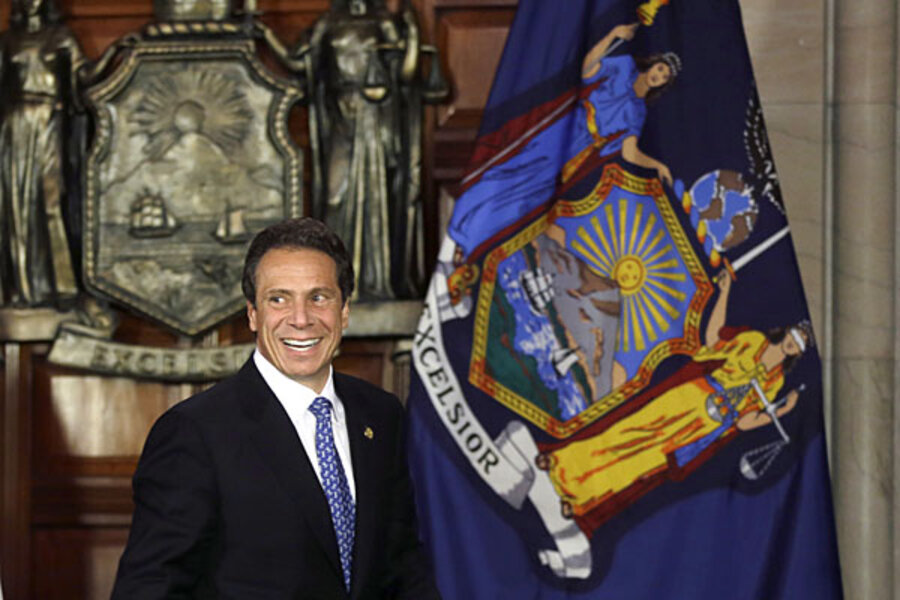Obamacare to slash premiums in New York. Was Obama right all along?
Loading...
| New York
One of the centerpieces of Obamacare bloomed Wednesday when New York Gov. Andrew Cuomo (D) announced the new state-run insurance exchange would cut costs by more than half.
State regulators have just approved the premiums the exchange will offer, and, on average, they represent a 53 percent reduction of previous individual rates. Any uninsured person or a small business with fewer than 50 employees will be able to purchase this insurance through New York’s Health Benefit Exchange, an online marketplace of 17 companies offering four grades of insurance – as mandated by President Obama’s 2010 Affordable Care Act.
Governor Cuomo noted that these new rates do not take into account the additional federal subsidies that will be offered to lower income residents, making the savings for some even greater.
The announcement is a victory for Obamacare, which Americans still view warily, according to polls. A Gallup poll last month found that 42 percent of respondents said Obamacare would make their lives tougher, compared with 22 percent who said it would improve their lives. The New York report provides evidence that Obamacare can drive costs down.
“For the individual market, which has always been really complex and really expensive, the Affordable Care Act is bringing down rates in states around the country – it’s introducing competition and bringing down costs for individuals,” says Eileen Elliott, a health care attorney with Dunkiel Saunders in Burlington, Vt.
But New York is not a typical case, others note. For one, the state has long required insurers to cover preexisting conditions – just as Obamacare now requires for the nation. It has also required more comprehensive care in individual plans than other states.
That means New York had instituted some of the most costly provisions in Obamacare before the federal law mandated them nationwide. Indeed, health insurance in the state has long been among the most expensive in the nation, especially for individuals. The average monthly premium for individuals in New York has been 66 percent higher than the national average, according to the Kaiser Family Foundation.
The result was that few New Yorkers bought health insurance unless they had to.
“New York is a little bit unique,” says Linda Tiano, a health care attorney with Epstein Becker Green in New York. “Nobody really wanted to be in that business in New York, or redesign their regular networks for individuals, and this made it a very, very expensive product.”
Now, the mandate for all to buy insurance should broaden the pool of payers, driving down costs. The health exchanges will also help streamline a system that was not easy to navigate previously.
With states facing an Oct. 1 deadline to begin enrolling residents in their new health-insurance exchanges, many states have not yet announced the premiums their exchanges will offer. But of those who have, none has had numbers as startling as New York’s.
In May, "Cover Oregon" posted the premiums for its online exchange and the cost savings varied, depending on the region and the profile of the individual. The “Covered California,” exchange, too, announced its premiums, though these have yet to be approved by state regulators.
Under Obamacare, states must offer their residents an online health exchange by Jan. 1, 2014. States can offer a health-insurance exchange like those of New York, California, and Oregon; 14 other states have already announced plans to do so. Seven states are planning to form partnership exchanges, and the remaining 27 states are simply defaulting to a federal exchange, according to a Kaiser report.
The potential flaw in New York's data, critics say, is the assumption that a significant number of the uninsured will sign up for these exchanges. The Affordable Care Act requires individuals to purchase insurance or pay a fine. Next year, the penalty will be $95 for each uninsured adult per household, or 1 percent of income. This increases to $325 in 2015, and then to $695 in 2016.
Some people might choose to pay the fine.
“Going on the premise that some of these healthy people are now going to sign up, then you assume your actuarial costs are going to be lower, because you assume utilization will be less than it is now,” Ms. Tiano says. “People made those assumptions; they may or may not turn out to be true.”
Small business would have faced similar fines, but the Obama administration delayed that mandate for a year. The effect of this delay, many point out, will be a boost to the exchange programs, and thus a boost for Obamacare.
“I originally thought this was about getting through the 2014 elections and cutting the Democrats a little bit of a break,” says Tom Considine, COO of MagnaCare and former commissioner of the New Jersey Department of Banking and Insurance. “I think now it's as much about politics – if you take away the employer mandate, then you have less employers offering health insurance. That will drive more people to the exchanges. So I think a lot of [the administration’s delay] may in fact be about building up lives in the exchanges.”





